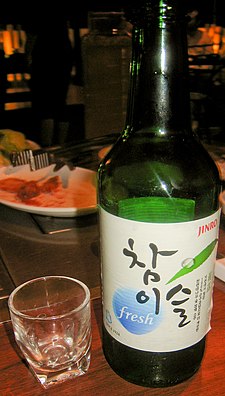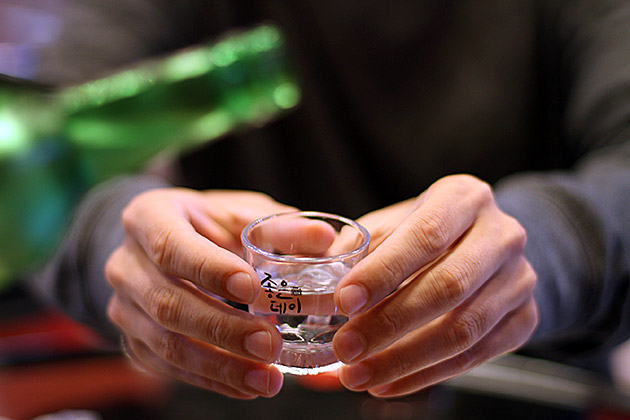Introduction
Soju, often referred to as South Korea's national drink, holds a significant place in the country's cultural heritage and social fabric. This clear distilled spirit, typically made from rice, barley, wheat, or sweet potatoes, has been consumed for centuries, evolving alongside Korea's rich history. Beyond its cultural significance, the vessel in which soju is served plays a pivotal role, reflecting tradition, innovation, and the interconnectedness of Korean society. In this blog, we delve into the importance of the glassware used in serving soju, exploring its historical context, cultural symbolism, and contemporary relevance.

The Evolution of Soju and Its Glassware
To understand the significance of soju's glassware, we must first trace the drink's origins. Soju's history dates back to the 13th century during the Mongol invasions of Korea, where it was initially introduced as arak. Over time, Korean distillers adapted the recipe, utilizing locally available ingredients and refining the distillation process, giving rise to the modern soju we know today.
During the Joseon Dynasty (1392–1910), soju gained prominence as a staple beverage among the ruling elite and commoners alike. Its production and consumption became deeply ingrained in Korean society, with distilleries proliferating across the peninsula. Glassware, predominantly crafted from ceramic or simple blown glass, accompanied the serving of soju, reflecting the aesthetics and craftsmanship of the time.
As Korea underwent modernization in the late 19th and early 20th centuries, soju production methods evolved, incorporating Western distillation techniques and equipment. This period witnessed the introduction of mass-produced glassware, marking a departure from traditional ceramic vessels. However, even amidst these changes, the cultural significance of soju and its accompanying glassware remained steadfast, serving as enduring symbols of Korean identity and conviviality.
Transport yourself to the vibrant streets of Seoul with a crystal-clear glass of soju in hand. As the evening breeze carries whispers of excitement, take a sip of this beloved Korean spirit, and let its smooth warmth envelop your senses. Whether you're unwinding after a long day or toasting to new beginnings with friends, the tradition of sharing soju creates moments of connection and camaraderie. With each sip, experience a taste of Korea's rich culture and hospitality, leaving you longing for just one more pour. Cheers to the magic of soju, where every glass holds a story waiting to be shared.
SHOP NOW: https://myseoulbox.com/pages/seoulbox-simple-shop

The Significance of Soju Glassware
In Korean culture, the act of sharing soju holds profound social significance, fostering camaraderie and strengthening interpersonal bonds. Central to this ritual is the vessel in which soju is served, which embodies cultural values and customs.
Traditionally, soju was served in small, shallow cups known as soju cups or "sul-jip." These cups, often made of porcelain or earthenware, feature simple designs adorned with auspicious symbols such as longevity motifs or traditional Korean patterns. The small size of these cups encourages frequent toasting and communal drinking, reinforcing the importance of kinship and hospitality in Korean society.
Beyond its functional role, soju glassware serves as a canvas for artistic expression, with craftsmen employing various techniques to embellish the vessels. From intricate hand-painted designs to delicate etchings, each piece of soju glassware reflects the skill and creativity of its maker, elevating the drinking experience into an aesthetic pleasure.
Moreover, the act of pouring and receiving soju is governed by a set of etiquette rules known as "Jeongseon," emphasizing respect for elders and hierarchical relationships. When serving soju, the younger individual holds the bottle with both hands and offers it to the elder, who receives it with one hand while supporting the forearm with the other—a gesture symbolizing deference and reverence.

Soju Glassware in the Modern Era
In recent years, the global popularity of Korean culture, particularly its cuisine and entertainment, has propelled soju onto the international stage. With this increased visibility, contemporary artisans and designers have sought to reimagine soju glassware, blending traditional craftsmanship with modern aesthetics to appeal to a diverse audience.
One notable trend is the fusion of traditional Korean motifs with minimalist design principles, resulting in sleek and elegant soju glasses that cater to contemporary tastes. These modern interpretations retain the essence of Korean craftsmanship while embracing innovation and experimentation in form and material.
Furthermore, advancements in glassmaking technology have enabled the production of soju glassware with enhanced durability and clarity, offering consumers a superior drinking experience. From crystal-clear glass to tinted or textured surfaces, the variety of options available reflects the diversity and dynamism of modern Korean society.
In addition to aesthetics, sustainability has emerged as a key consideration in the design and production of soju glassware. With growing awareness of environmental issues, many manufacturers have begun exploring eco-friendly materials and production methods, aligning with consumers' values and preferences.
Despite these contemporary developments, the fundamental role of soju glassware remains unchanged—it serves as a conduit for shared experiences, fostering connections and creating lasting memories. Whether enjoyed in a traditional setting or a trendy cocktail bar, the act of raising a glass of soju transcends cultural boundaries, uniting people in celebration and camaraderie.

10 Fun facts about this soju glass

1. Alcohol Content: Soju is known for its relatively high alcohol content compared to other popular spirits. Traditional soju typically has an alcohol by volume (ABV) ranging from about 16% to 25%, though modern variations may have higher or lower percentages.
2. Cultural Significance: Soju holds a significant place in Korean culture and social gatherings. It is often enjoyed during meals, celebrations, and various social occasions, serving as a symbol of camaraderie and bonding among friends, family, and colleagues.
3. Soju Glass Design: The traditional soju glass, known as a "cup" or "shot glass" in Western contexts, typically features a small, cylindrical shape with a narrow opening. This design is intended to enhance the aroma and flavor of the soju while allowing for controlled pouring and sipping.
4. Drinking Rituals: In addition to the two-step pour mentioned earlier, there are various drinking rituals associated with soju in Korean culture. These may include respectful gestures such as turning away while taking a sip, using both hands to receive or pass the bottle, and offering drinks to elders before taking one yourself.
5. Cultural Export: Soju has gained popularity beyond Korea and is now enjoyed by people around the world. Its versatility, unique flavor profile, and relatively affordable price point have contributed to its global appeal. As a result, soju-inspired cocktails and fusion dishes incorporating soju have emerged in bars and restaurants worldwide, showcasing the spirit's adaptability in diverse culinary contexts.
6. Customized Glasses: Some establishments or events may offer customized soju glasses featuring logos, slogans, or designs specific to the occasion. These personalized glasses can serve as mementos for attendees and add an extra touch of uniqueness to the drinking experience.
7. Drinking Games: Soju is often enjoyed during social gatherings, where drinking games such as "Korean Drinking Games" are popular. These games involve various rules and challenges, adding an element of fun and camaraderie to the drinking experience.
8. Collectible Items: Some people collect soju glasses as souvenirs or decorative items, especially ones featuring unique designs or branding from popular soju brands. Collectors may seek out rare or vintage glasses to add to their collections.
9. Modern Interpretations: With the growing popularity of soju worldwide, modern interpretations of soju glasses have emerged. These may include sleek and minimalist designs or innovative features such as LED lighting for added visual appeal.
10. Materials: While traditional soju glasses are made of glass, you can also find variations made from ceramic or even plastic. Each material offers a unique drinking experience, with glass being the most common choice for its clarity and elegance.
Conclusion
Soju, with its rich history and cultural significance, embodies the essence of Korean identity and hospitality. Central to the soju-drinking experience is the vessel in which it is served, which reflects tradition, craftsmanship, and social customs. From humble ceramic cups to sleek modern glasses, soju glassware has evolved alongside Korean society, adapting to changing tastes and preferences while retaining its symbolic importance.
As we raise our glasses in a toast, let us not only savor the exquisite taste of soju but also cherish the traditions and values it represents. In every sip, we honor the legacy of generations past and celebrate the enduring spirit of Korean culture.
In this journey through tradition and innovation, the humble glass becomes a vessel of memory and meaning, uniting us in the timeless ritual of sharing and connection. So let us raise our glasses once more—to friendship, to family, and to the boundless possibilities that lie ahead.
Cheers, or as they say in Korean, 건배 (geonbae)!
Image credits:
https://for91days.com/photos/Busan/Soju/Soju-Busan.jpg
https://upload.wikimedia.org/wikipedia/commons/thumb/9/91/Korean_drink-Soju-01.jpg/225px-Korean_drink-Soju-01.jpg
https://upload.wikimedia.org/wikipedia/commons/thumb/a/ad/%EC%95%88%EB%8F%99%EC%86%8C%EC%A3%BC_%ED%98%B8%EB%A6%AC%EB%B3%91%28andongsoju%29.jpg/330px-%EC%95%88%EB%8F%99%EC%86%8C%EC%A3%BC_%ED%98%B8%EB%A6%AC%EB%B3%91%28andongsoju%29.jpg
https://media.licdn.com/dms/image/D5612AQHSFCALlVxntQ/article-inline_image-shrink_1000_1488/0/1699663228669?e=1715817600&v=beta&t=H_USza4N3Ps73B-w7A0M7aYD5XF5uWdBau9fQhinCOk
https://m.media-amazon.com/images/I/61Iof-FFBpL.jpg






